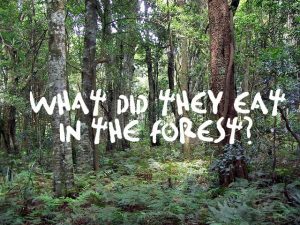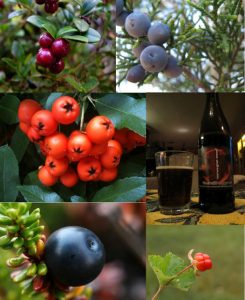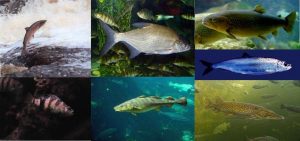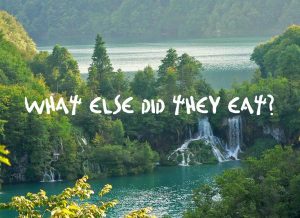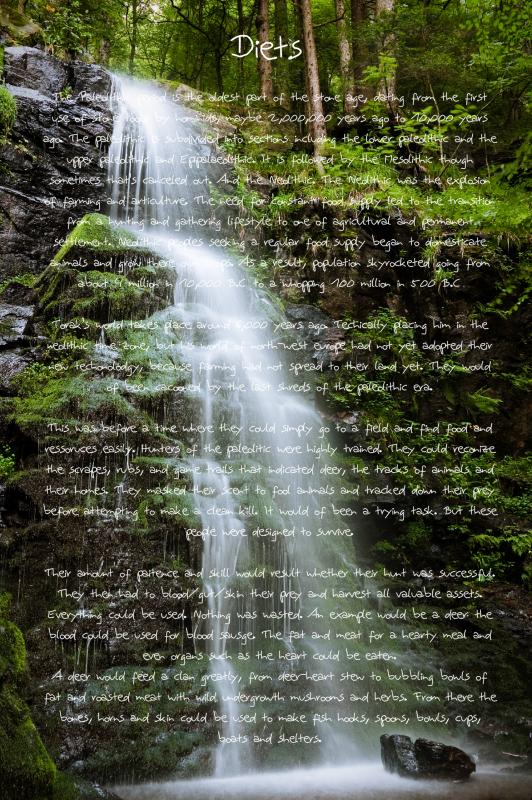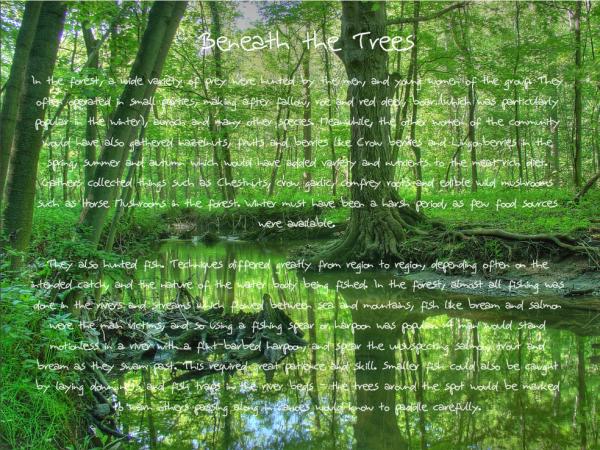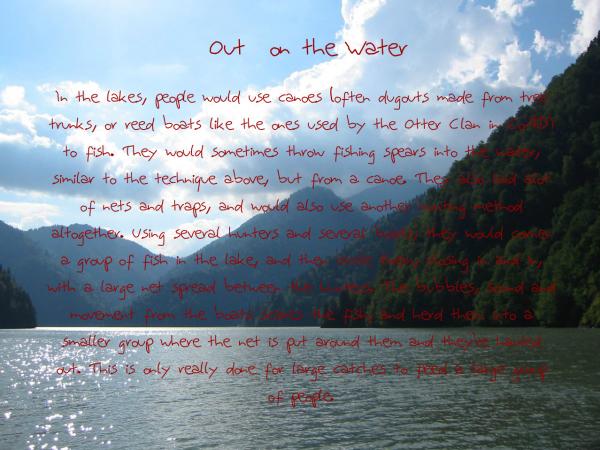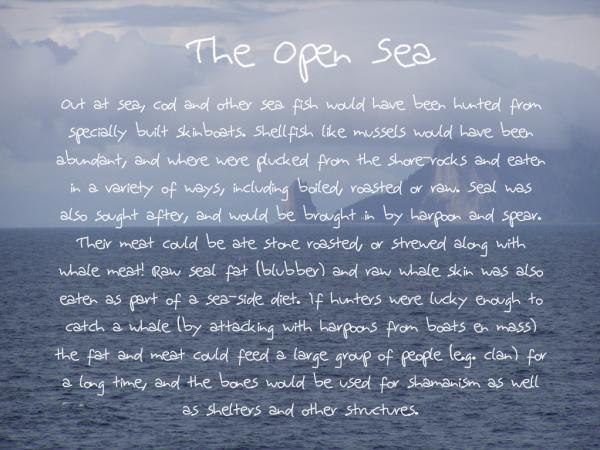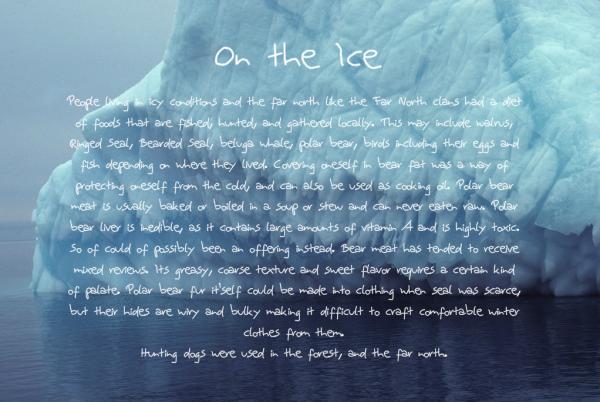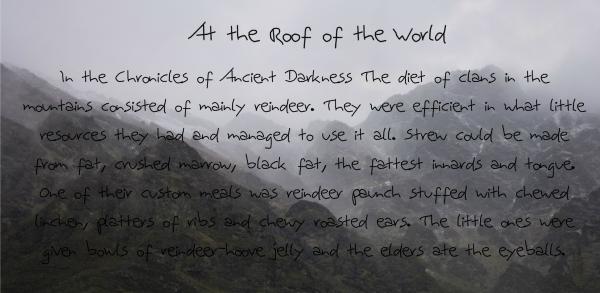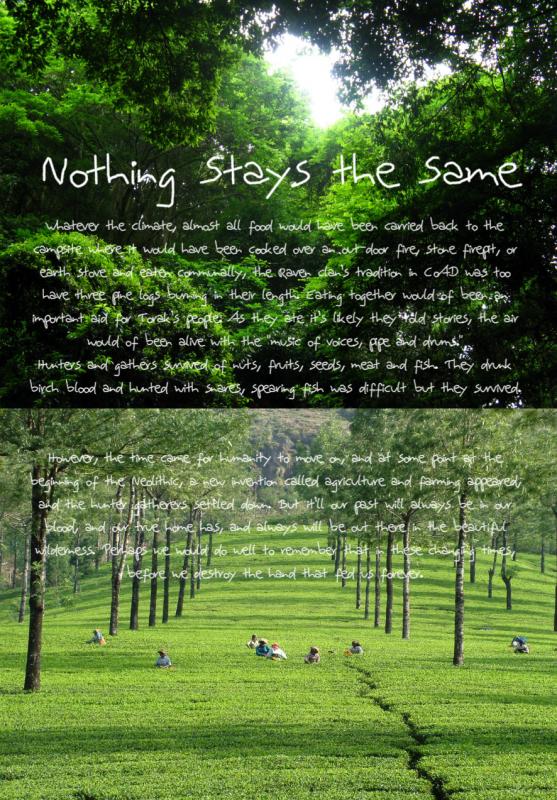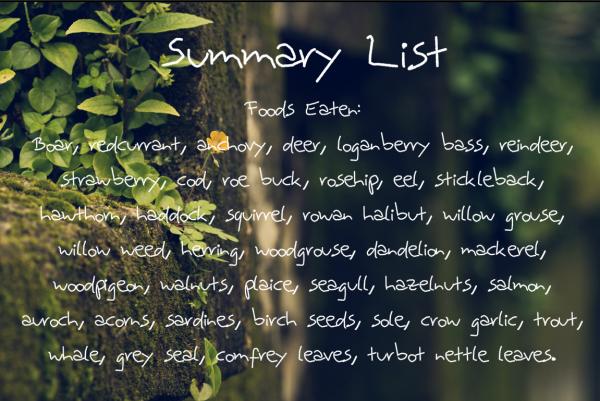The Mesolithic Meal Time
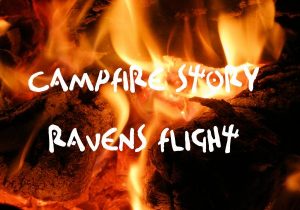 Click the picture above to download a campfire story, as imagined by Mountain Goat (pdf)
Click the picture above to download a campfire story, as imagined by Mountain Goat (pdf)
Pictures taken by Foggie on her walk in the woods. The mushrooms are yet to be identified, and the berries are wild blackberries.
Remember! Never eat any fungi you see in the wild, unless you are totally certain they are edible, and if you feel at all ill after – GET YOURSELF TO A DOCTOR!
It’s also best to wash any wild blackberries before eating them.
Forest prey. This collage is of the animals (mainly mammals) that roam the floor of the forest. They would make up almost all of the meat percentage of a Paolithic diet. Remember, in CoAD – and in real life groups of the time, some species would be sacred, or in CoAD forbidden to eat by clan law. Therefore boars and forest horses would not be eaten by their own clan, but other clans would have no problem consuming them (for instance, the boars are described as bringing a “whole side” of forest horse to the feast at the end of Outcast.
I’m doing descriptions line by line left to right in each collage.
- Wild boar. Normally the centre of a feast, roasted and flavoured with herbs and nuts. Obviously not eaten by Boar clan. Was often stewed.
- Frogs. Eaten by the Otter Clan, however the other clans were not so fond of them, although it can be assumed they would be consumed in times of shortage (as Torak does when he is Outcast).
- Roe Deer. Like the boar, would be the main part of a meal or feast, roasted and flavoured, or stewed. There was a Roe Deer clan in CoAD but they died out long ago.
- Elk. These were large and dangerous animals which only experienced hunters working as a team would bring down. All the references to Elk in CoAD are in stews, although it would be sensible to assume they were roasted too.
- Auroch. An extinct species of cattle, like the Elk they very enormous and very powerful, so only the best could hunt them. As well as probably being roasted and stewed, the Ravens are known for making Auroch-gut blood-sausage (see below). The Auroch Clan would obviously not eat their own.
- Forest Horse. This picture is probably not of a forest horse that would have been around in CoAD, but a close relative living in Mid-Europe. The Boar clan in CoAD are described as bringing a whole “side of forest horse” to a feast. They were roasted and garnished to taste. The Forest Horse clan would obviously not eat their own, and the Forbidden Herd in the Deep Forest were not to be touched or hunted by any.
- Woodgrouse. A relative of the pheasant or chicken, the Grouse is wild game, and the woodgrouse was probably a forest variant of the common grouse (in the picture). Snares would be left to catch them – often on the low boughs and branches they ran over. Normally roasted or stewed. Often more use to the lone hunter for a good meal, than the ability to feed a whole clan (like a boar or elk).
- Blood sausage. The sausage in the picture is made from pork. It probably looks quite similar in style to the infamous Raven Auroch sausage. The auroch meat is wrapped in guts of the animal and seasoned with hazelnuts and herbs. They were the precursor of the modern sausage.
Berries and fruit made up a substantial portion of a hunter gatherer’s diet. Normally used only as seasoning or cooking by groups of people (who used them as like an add-on to the large amount of meat they were able to bring in). However for a lone hunter whom, like Torak for long periods of the series, fruits and berries were vital to keep you them alive. Palae/Neolithic peoples had extensive knowledge of which plants were edible or not, which is very important to avoid eating a dodgy berry. A slight downside to this method of locating food is that during winter moons, the trees and bushes were bare.
- Lingonberries can be eaten both raw, or more often used as flavouring in other foods. For instance the Raven Clan made Salmon cakes with dried lingonberries (these being a particular favourite of Wolf’s in CoAD).
- Juniper berries were also picked or used in cooking or even for their juice or ability to produce alcohol.
- Rowan berries could be eaten or used in cooking or for making ales/brews. In CoAD the Willow clan produces their infamous Rowan berry brew from fermented Rowan berries.
- This is an Ale Brewed from Juniper berries. The people of Torak’s time had already mastered the act of producing alcohol from berries. This Juniper Ale recipe has probably hardly changed since the Palaeolithic times. It’s also probably very similar to the Rowan berry Brew the Willow clan would make in CoAD, just using fermented juniper berries rather than Rowan berries.
- Crow berry was another fruit hunter gatherers would have consumed. Could have been eaten or used in cooking too and in Wolfbrother Torak ate several in his flight from the bear.
- Cloud berries are still popular today, and were certainly abundant in Torak’s time, he being mentioned to have eaten some on several occasions. They too could probably be used in cooking as well.
The Clans who inhabit the coast of Torak’s world rely very heavily on the sea fish which hug the coastline, the Whale and Sea Eagle people have proved themselves both traders and excellent fishermen. Meanwhile, at Lake Axhead, the Otter Clan’s only source of food is the watery creatures who inhabit the freshwater lake they live upon. Even in the forest itself, the rivers Widewater, Axehandle, and many others are sources of food to the men of the trees, particulourly in the Salmon Run. The Palaeolithic and Neolithic people also understood the importance of farming the oceans (just like in Michelle’s books), fish would have been a major percentage of their diet.
- Salmon spend most of their lives out in the open Ocean, however when their time came to reproduce, they return to their spawning points in the rivers and lakes of Europe and North America. In one of the great natural wonders, they travel thousands of miles back to their original spawning spots – where they themselves hatched. In great numbers they head from the ocean to the rivers, where – against the current, they push upriver towards their breeding spots. This spectacle is known as the Salmon Run and occurs every Spring. The people of the time (and in Michelle’s book, the people of the Open Forest) would pitch camp near rivers and streams in order to spear the salmon moving up through them. It is unclear whether the Salmon Clan ate their own creature, as the Salmon Run was a vital aspect of survival for people of the forest after winter.
- Bream are a large freshwater fish. They would be caught in nets or fish traps laid by hunters. Like most fish they can be cooked in a variety of ways, namely baking, cooking on a spit, roasting or stewing. Bream inhabit all the rivers in CoAD.
- Trout are a relative of the salmon who do not migrate, and live in the freshwater rivers as oppose to the sea. They are caught in nets or fish traps, roasted, bakes or stewed. They also inhabit all the rivers of CoAD.
- Herring are a small sea fish who travel in large shoals for safety. They are caught in large numbers by nets by the hunters and can be cooked in a variety of ways. In CoAD the Open Forest Clans who live on the coast salt them – the Willows being especially fond of this method.
- Sticklebacks are a very small and unusual freshwater fish. They have no scales but spines instead. In CoAD they are a major source of the Otter Clan and live en masse in Lake Axehead. The Otters make a grease from their bodies – however it is an unusual taste which does not go down well with many visitors.
- Cod are a salt water sea fish who live in the oceans and seas. The Seal Clans, and indeed most island people in Europe would have eaten many of them. Roasted, salted, baked, there are many ways to eat cod. It is also mentioned by Bale in Outcast, that the Clans of the Seal Islands make a grease from cod similar to that produced by the Otter’s from sticklebacks
- Pikes are freshwater fish. They are large, thin and sleek with large gaping mouths and big teeth – they are the hunters of the rivers and lakes. People of the Paolithic and Neolithic would have honoured and revered the pike for being one of the best hunters, and fastest movers of the water. However they could be eaten, but their flesh is thin and their bodies bony, but hunters did not go out aiming to catch them unless times were dire indeed.
When in need of water or food, slitting the bark of certain trees (if they’re in the right position) can open up the main internal transport system in a plant (the xylem/phloem). A tree transports its proteins and carbohydrates between parts of the plant via this system. Glucose (the form of carbohydrate produced by photosynthesis) is turned to sucrose by the isomerase enzyme. Sucrose is highly soluble to dissolves straight into the water which transports stuff through the phloem/xylem. Also dissolved in there are minerals like phospherus (in phosphate) form.
By tapping in there, people of Torak’s time were able to place a cup beneath their hole, and the sap/transport solution will drip into the cup, making a refreshing and strengthening drink. Birch trees are particularly useful for this, and Torak takes advantage of one being in his area during Outcast.
Nuts, seeds and plants would also have made up reasonable amount of a hunter gatherer’s diet during the Neolithic and Palaeolithic eras. Life berries, nuts and seeds would not have been the main proportion of the meal for the feeding of a large group or clan, however a lone hunter gatherer would rely on the plants he/she could find as much as the prey they could bring down. For a large clan, plants would be used more in magecraft, cooking or flavouring, as well for snacks.
- Chestnuts are still eaten today. Roasted and eaten with a meal of by themselves but can only be found in the autumn.
- Orchids were not only pretty flowers to Torak’s people! Their roots were rough, starchy and almost resembled glue when eaten, are described as being the most nourishing food in the forest if you “couldn’t get meat” by Torak – another case of food not normally eaten by a group of people who could hunt, but a lifeline to a lone hunter gatherer.
- Sorrel leaves are a relative of spinach. Their leaves can be eaten (as Torak does in Outcast) but taste bitter and were probably not eaten raw unless it could be avoided. Sorrel leaves are often used in soups, sauces and salads, however they contain oxalic acid, which is large doses can be a fatal poison! *Yes I am aware the picture is of clovers not sorrel leaves, I must have selected the wrong picture when I made the collage – I will rectify it as soon as I have the time*
- Long grass would not have been eaten, the human appendix has evolved over time to be far too small to digest the roughage. However people of Torak’s time would have used grass seeds to determine wind-direction during hunting (a tactic which has been used for millennia since). I just thought it would be interesting to include it.
- Hazelnuts could be eaten raw by a passing hunter, or ground/crushed into small pieces and sprinkled on food. They were also used to flavour everything from soups to blood sausage to fruit.
- Pignuts are the underground (root) section of the Conopodium majus herb. They can be dug up and eaten straight away (resembling chestnuts), they are called pignuts due to their association with wild boar and pigs who are particularly fond of them.
- Marrowfat peas are what we call peas which have naturally matured/dried out. What you may not realise, is that garden peas (e.g. what you buy from bird’s eye) are actually peas harvested in the “prime of their youth” on not fully developed. When left to themselves they will rnd up as marrowfat peas. We let this happen now as mushy and wasabi peas can only be produced by marrowfat. In the Neolithic/Palaeolithic they would have been used in cooking, in blood sausage, soups, flavouring meat, and probably in some sort of ancient version of mushy peas!

